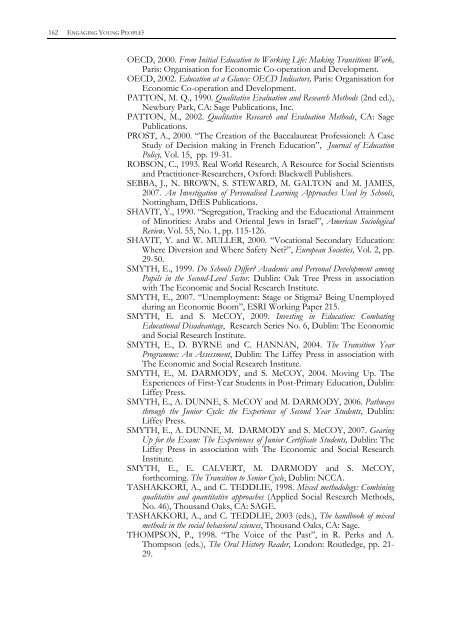Student Experiences of the Leaving Certificate Applied Programme
Student Experiences of the Leaving Certificate Applied Programme
Student Experiences of the Leaving Certificate Applied Programme
You also want an ePaper? Increase the reach of your titles
YUMPU automatically turns print PDFs into web optimized ePapers that Google loves.
162 ENGAGING YOUNG PEOPLE?OECD, 2000. From Initial Education to Working Life: Making Transitions Work,Paris: Organisation for Economic Co-operation and Development.OECD, 2002. Education at a Glance: OECD Indicators, Paris: Organisation forEconomic Co-operation and Development.PATTON, M. Q., 1990. Qualitative Evaluation and Research Methods (2nd ed.),Newbury Park, CA: Sage Publications, Inc.PATTON, M., 2002. Qualitative Research and Evaluation Methods, CA: SagePublications.PROST, A., 2000. “The Creation <strong>of</strong> <strong>the</strong> Baccalaureat Pr<strong>of</strong>essionel: A CaseStudy <strong>of</strong> Decision making in French Education”, Journal <strong>of</strong> EducationPolicy, Vol. 15, pp. 19-31.ROBSON, C., 1993. Real World Research, A Resource for Social Scientistsand Practitioner-Researchers, Oxford: Blackwell Publishers.SEBBA, J., N. BROWN, S. STEWARD, M. GALTON and M. JAMES,2007. An Investigation <strong>of</strong> Personalised Learning Approaches Used by Schools,Nottingham, DfES Publications.SHAVIT, Y., 1990. “Segregation, Tracking and <strong>the</strong> Educational Attainment<strong>of</strong> Minorities: Arabs and Oriental Jews in Israel”, American SociologicalReview, Vol. 55, No. 1, pp. 115-126.SHAVIT, Y. and W. MULLER, 2000. “Vocational Secondary Education:Where Diversion and Where Safety Net?”, European Societies, Vol. 2, pp.29-50.SMYTH, E., 1999. Do Schools Differ? Academic and Personal Development amongPupils in <strong>the</strong> Second-Level Sector. Dublin: Oak Tree Press in associationwith The Economic and Social Research Institute.SMYTH, E., 2007. “Unemployment: Stage or Stigma? Being Unemployedduring an Economic Boom”, ESRI Working Paper 215.SMYTH, E. and S. McCOY, 2009. Investing in Education: CombatingEducational Disadvantage, Research Series No. 6, Dublin: The Economicand Social Research Institute.SMYTH, E., D. BYRNE and C. HANNAN, 2004. The Transition Year<strong>Programme</strong>: An Assessment, Dublin: The Liffey Press in association withThe Economic and Social Research Institute.SMYTH, E., M. DARMODY, and S. McCOY, 2004. Moving Up. The<strong>Experiences</strong> <strong>of</strong> First-Year <strong>Student</strong>s in Post-Primary Education, Dublin:Liffey Press.SMYTH, E., A. DUNNE, S. McCOY and M. DARMODY, 2006. Pathwaysthrough <strong>the</strong> Junior Cycle: <strong>the</strong> Experience <strong>of</strong> Second Year <strong>Student</strong>s, Dublin:Liffey Press.SMYTH, E., A. DUNNE, M. DARMODY and S. McCOY, 2007. GearingUp for <strong>the</strong> Exam: The <strong>Experiences</strong> <strong>of</strong> Junior <strong>Certificate</strong> <strong>Student</strong>s, Dublin: TheLiffey Press in association with The Economic and Social ResearchInstitute.SMYTH, E., E. CALVERT, M. DARMODY and S. McCOY,forthcoming. The Transition to Senior Cycle, Dublin: NCCA.TASHAKKORI, A., and C. TEDDLIE, 1998. Mixed methodology: Combiningqualitative and quantitative approaches (<strong>Applied</strong> Social Research Methods,No. 46), Thousand Oaks, CA: SAGE.TASHAKKORI, A., and C. TEDDLIE, 2003 (eds.), The handbook <strong>of</strong> mixedmethods in <strong>the</strong> social behavioral sciences, Thousand Oaks, CA: Sage.THOMPSON, P., 1998. “The Voice <strong>of</strong> <strong>the</strong> Past”, in R. Perks and A.Thompson (eds.), The Oral History Reader, London: Routledge, pp. 21-29.

















